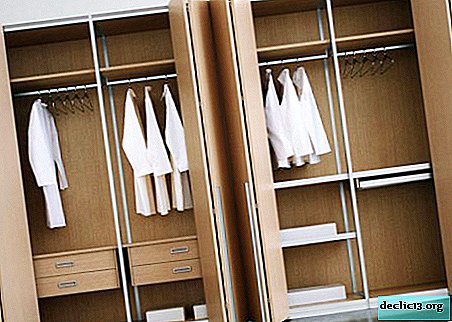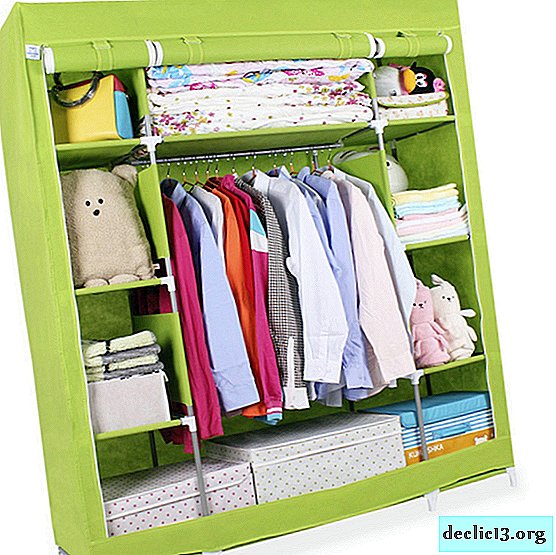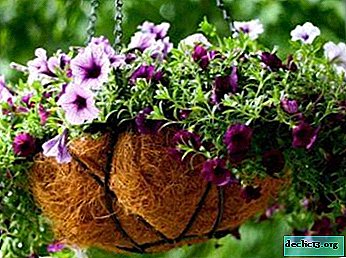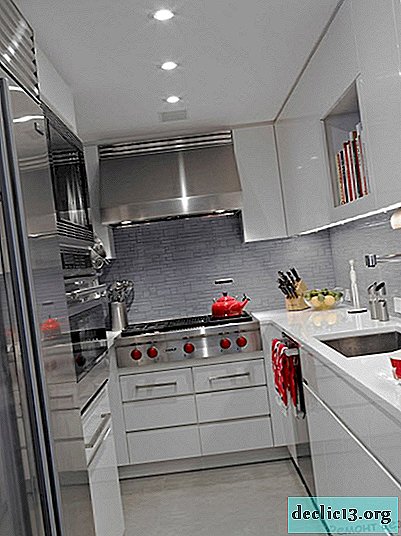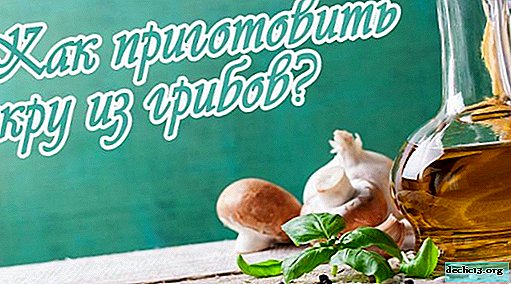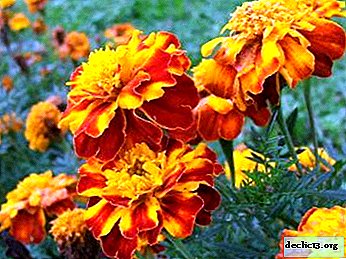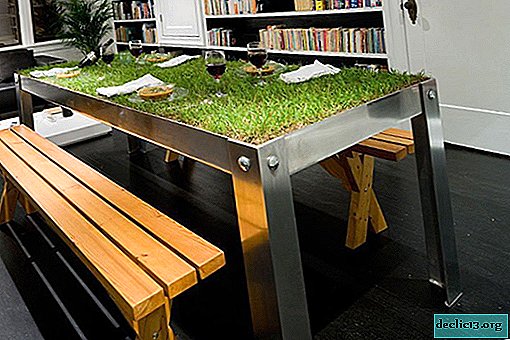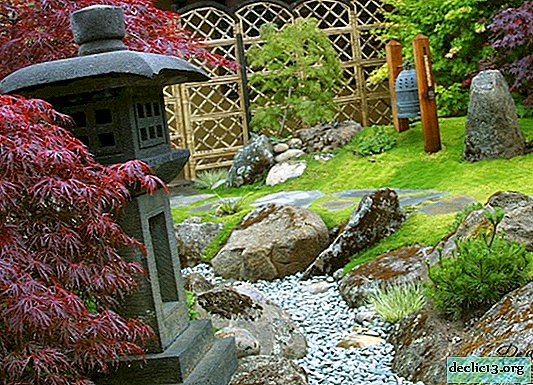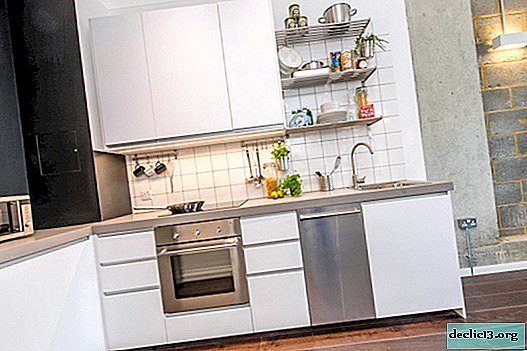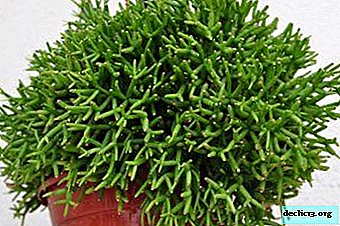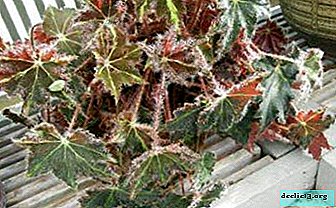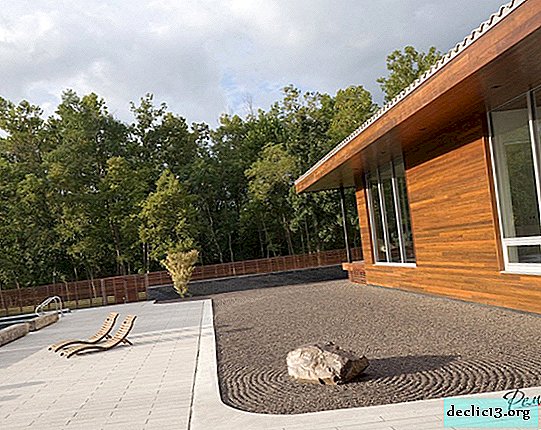Pelargonium Clara San - how to care and grow?
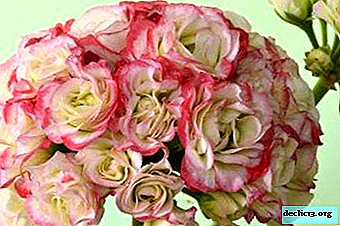
Among the variety of pelargonium varieties, the so-called zonal and rose-bearing varieties deserve special attention. These varieties are distinguished by particularly decorative flowering and delicate shades of petals.
In the article, we will talk about such a variety of zonal pelargoniums as Clara San, one of the latest innovations in breeding work. We will consider the features of this variety, find out how to plant and how to care for Clara pelargonium so that it grows safely and beautifully blossoms.
Description
Pelargonium Clara San - the brainchild of artificial targeted selection. The plant has a beautiful appearance, is a wonderful decoration of the home, is able to harmonize the microclimate, and has medicinal properties.
reference. On sale this plant appeared only in 2016, being bred a little earlier.Along with the remarkable appearance, Klara’s pelargonium is also quite unpretentious. However, it needs high-quality pruning - otherwise it will not be possible to form a lush bush.
Appearance
 The advantage of the variety is that Clara pelargonium blooms in an unusual way: its inflorescences resemble a small size of a rose. The color of the petals is appropriate - very delicate pinkish with a light green core. The diameter of one bud is 3.5 cm.
The advantage of the variety is that Clara pelargonium blooms in an unusual way: its inflorescences resemble a small size of a rose. The color of the petals is appropriate - very delicate pinkish with a light green core. The diameter of one bud is 3.5 cm.
The buds are collected in lush inflorescences, giving the plants a special decorative look. Note that the flowering season in the Clara Pelargonium is very long - the plant pleases with its decorativeness from about March to November.
However, for the plant to bloom for so long, you will have to take good care of it: Pelargonium Clara loves the sun, not too voluminous pot, fertilizing and watering. Next, we will talk about all the features of cultivation and care.
Landing
We learn the requirements of this plant to its habitat, soil, lighting.
Location and Lighting
In order for Pelargonium Clara to please its flowering for a long time, it is necessary to place its pot in a bright place. Like all geraniums, this plant does not like shade. If Clara does not have enough light, decorative flowering will not work: there will be few inflorescences, and those that appear in large sizes will not differ.
Attention. With a lack of lighting, the color of the foliage noticeably fades, which also negatively affects the appearance of the flower. Direct sunlight is dangerous for this plant, so at noon in the summer it is recommended to shade the pot with translucent paper or cloth. In winter, it is necessary to organize additional lighting for the plant in the form of an artificial light lamp.If this measure is not foreseen, the flowering period will decrease, and the buds themselves will become much less lush and decorative. Besides, with a lack of light, Klara stretches the stems, the leaves turn pale. This also negatively affects the beauty of the plant.
The soil
 As for the composition of the soil, in this regard, the pelargonium of Clara is not particularly demanding. Much more important for the plant is good drainage.
As for the composition of the soil, in this regard, the pelargonium of Clara is not particularly demanding. Much more important for the plant is good drainage.
Do not forget to put a layer of expanded clay on the bottom of the pot. Geranium does not tolerate wetlands.
Its delicate roots can easily rot in such conditions. In the best way, Pelargonium Klara San will feel in the soil with either a neutral or slightly acidic reaction.
Experienced flower growers add ash to the soil if it is too acidic. Recommended substrate composition:
- sheet land - 1 part;
- sod - 1 part;
- peat - 1 part;
- sand - 1 part.
If the soil is not too nutritious, you can also add humus. In the store you can buy a ready-made substrate for geraniums - in this case, it is optimal.
Care
We will get acquainted with the main points for caring for this decorative plant.
Watering
Regular soil hydration is very important for Klara’s pelargonium. Although watering should be quite plentiful, it is also important not to allow overmoistening of the soil. Otherwise, the roots of the plant may begin to rot. Therefore, water only when the top layer of the substrate dries.
Tip. In summer, the plant is watered daily, and in winter, once every three days is enough. It is also recommended to loosen the top layer of the substrate after irrigation to ensure good soil aeration. Clara does not need spraying pelargonium.If there is a need to moisten the air, then this must be done using a spray gun, directing the stream to the area around the pot, and not to the plant itself.
Top dressing
 The plant needs additional nutrition. Clara reacts to the competent application of the necessary fertilizers with a longer and more magnificent flowering.
The plant needs additional nutrition. Clara reacts to the competent application of the necessary fertilizers with a longer and more magnificent flowering.
In spring, the plant needs nitrogen compounds, and at the beginning of the formation of inflorescences it is better to focus on potassium-phosphorus complexes. In the store you can buy a comprehensive mineral composition for pelargonium. It is suitable in this case optimally.
It is important to know that Pelargonium doesn't like organic top dressing. It is also important not to exceed the dose of fertilizer prescribed by the instructions.
If you overfeed, the roots of pelargonium may well get a chemical burn. The frequency of fertilizing during the growing season is twice a month, in winter the plant does not need additional nutrition.
Pruning
Only competent and timely pruning will be able to give the pelargonium bush the correct compact form, and protect the plant from elongated ugly shoots. Note that it was the inability to correctly cut the flower that at one time caused the pelargonium to lose popularity among flower growers. To form a compact and lush bush, you must regularly pinch the apical parts of young shoots. This measure will allow the plant to grow in breadth and form a larger number of peduncles.
As a rule, pinch shoots in young plants after the appearance of four to five pairs of leaflets on them. The most suitable time for pruning is the spring months. And if pinching is used for young shoots, then pruning is used for adult plants.
Attention. To make the cut even and less traumatic for the bush, you should use a clean and very sharp knife. And after the procedure, it is necessary to sprinkle the cut points with charcoal, wood ash or grease with green paint.The plant requires special attention in the first year of its life. During this period, it is necessary to spend the maximum amount of effort for the formation of the correct form of the bush. But in the second and subsequent years you can already relax: the formed shrub will require only "cosmetic" pruning.
Diseases and Pests
 Like all other types of indoor plants, Pelargonium Clara may be susceptible to attack by harmful insects, as well as various diseases of flowers. Some of them can be fatal.
Like all other types of indoor plants, Pelargonium Clara may be susceptible to attack by harmful insects, as well as various diseases of flowers. Some of them can be fatal.
Next, we consider which of the dangers pose the greatest threat to this pelargonium. Is this danger great and can it be avoided.
We will also analyze how they can be fraught. What of all of the above can be defeated, and what cannot be cured, you will learn further.
As for parasites, in this case the most dangerous are the following pests:
- aphid;
- spider mite;
- whitefly.
To cope with the tick, you will need to use special fungicidal preparations. A whitefly and aphids will be able to destroy funds containing permethrin.
Of the diseases, root rot is the most dangerous for the plant - the so-called "black leg". The disease occurs if the soil moisture regime is impaired.
Note that the black leg is not treated, and if this disease occurs, pelargonium will have to be destroyed. In order to prevent the disease, it is recommended that the soil is thoroughly sterilized before planting, and also that waterlogging of the substrate is not allowed.
Breeding
Pelargonium Klara San reproduces well at home using the method of dividing the bush, as well as cuttings. It is better to carry out the breeding procedure either in early spring, or in mid-late summer. In addition, seed reproduction of the plant is possible, however, the hassle in this case will be much more. Further instructions regarding the different methods of propagation of pelargonium.
Seeds
 In this case, the seeds are planted in the ground around January. The soil should be slightly moist and fairly loose, nutritious.
In this case, the seeds are planted in the ground around January. The soil should be slightly moist and fairly loose, nutritious.
From above, the container with planted seeds must be covered with polyethylene so that the seedlings appear faster. The optimum outside temperature is + 20-24 degrees.
Periodically, the soil must be sprayed from the spray gun. Seedlings usually appear 15-20 days after planting seeds.
As soon as a couple of leaves appear, shoots are recommended to dive, and then continue growing for another two months. Then mature shoots are transplanted into separate pots.
Cuttings
 To get full cuttings, it is recommended to cut the lateral and apical shoots from the mother plant. The stalk should not exceed 7 cm in length, and at least 2-3 leaves must be present on it. The slice must be sprinkled with activated charcoal, and then dry the stalk for a couple of hours, wrapped in paper. After drying, the stalk is planted in the ground, and then the container must be placed in a warm place.
To get full cuttings, it is recommended to cut the lateral and apical shoots from the mother plant. The stalk should not exceed 7 cm in length, and at least 2-3 leaves must be present on it. The slice must be sprinkled with activated charcoal, and then dry the stalk for a couple of hours, wrapped in paper. After drying, the stalk is planted in the ground, and then the container must be placed in a warm place.
When watering the soil, it is important to direct the stream only to the ground, without touching the leaves of the stem. Otherwise, the escape can rot, not having time to take root. Within a month, with proper maintenance and care, the shoot is rooted.
Conclusion
We learned what constitutes such an ornamental plant as Klara's pelargonium. This flower looks very impressive, and at the same time it is not too capricious when grown. Therefore, Clara is suitable, including for beginner gardeners, decorate the windowsill with its unusual two-color buds, and with proper care will be able to maintain decorativeness for a long time.

